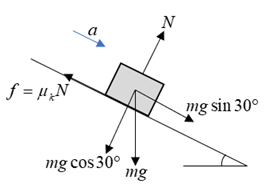Suppose a small box with a mass of 43.0 kg is moving at 7.00 m/s along a flat horizontal surface immediately before it begins travelling down a slope. The slope is at an angle of 30.0°, has a length of 28.0 m, and the coefficent of kinetic friction between the slope and the box is 0.850. vo m d 30.0°
Suppose a small box with a mass of 43.0 kg is moving at 7.00 m/s along a flat horizontal surface immediately before it begins travelling down a slope. The slope is at an angle of 30.0°, has a length of 28.0 m, and the coefficent of kinetic friction between the slope and the box is 0.850. vo m d 30.0°
College Physics
11th Edition
ISBN:9781305952300
Author:Raymond A. Serway, Chris Vuille
Publisher:Raymond A. Serway, Chris Vuille
Chapter1: Units, Trigonometry. And Vectors
Section: Chapter Questions
Problem 1CQ: Estimate the order of magnitude of the length, in meters, of each of the following; (a) a mouse, (b)...
Related questions
Topic Video
Question

Transcribed Image Text:**Problem Statement:**
Suppose a small box with a mass of 43.0 kg is moving at 7.00 m/s along a flat horizontal surface immediately before it begins traveling down a slope. The slope is at an angle of 30.0°, has a length of 28.0 m, and the coefficient of kinetic friction between the slope and the box is 0.850.
**Diagram Explanation:**
The diagram illustrates the setup described above:
- A rectangular box, labeled with mass \( m \), is shown on a flat surface moving towards a downward slope.
- The initial velocity of the box (\( v_0 \)) is indicated as 7.00 m/s, shown with an arrow pointing to the right.
- The slope, represented by a blue triangular shape, is inclined at an angle of 30.0°.
- The hypotenuse of the triangle, representing the length of the slope, is labeled \( d \) and measures 28.0 m.
- The angle of the slope is indicated to be 30.0°.
This setup is commonly used in physics problems to analyze motion along inclined planes, taking into account forces like gravity and friction.

Transcribed Image Text:**Problem Statement:**
How far down the slope, \( d \), will the box travel before coming to a complete stop?
**Hints:**
- A section labeled "View Available Hint(s)" suggests that additional guidance or tips might be available to solve the problem.
**Input Box:**
- An input field is provided where you can calculate and enter the value of \( d \), in meters (m).
- The interface includes various tools such as:
- A button for mathematical symbols
- Options to undo or redo actions
- A button to reset the input
- A help icon for additional assistance
Enter your calculated distance \( d \) in the space provided.
Expert Solution
Step 1
Draw the free-body diagram of the box.

Step by step
Solved in 4 steps with 1 images

Knowledge Booster
Learn more about
Need a deep-dive on the concept behind this application? Look no further. Learn more about this topic, physics and related others by exploring similar questions and additional content below.Recommended textbooks for you

College Physics
Physics
ISBN:
9781305952300
Author:
Raymond A. Serway, Chris Vuille
Publisher:
Cengage Learning

University Physics (14th Edition)
Physics
ISBN:
9780133969290
Author:
Hugh D. Young, Roger A. Freedman
Publisher:
PEARSON

Introduction To Quantum Mechanics
Physics
ISBN:
9781107189638
Author:
Griffiths, David J., Schroeter, Darrell F.
Publisher:
Cambridge University Press

College Physics
Physics
ISBN:
9781305952300
Author:
Raymond A. Serway, Chris Vuille
Publisher:
Cengage Learning

University Physics (14th Edition)
Physics
ISBN:
9780133969290
Author:
Hugh D. Young, Roger A. Freedman
Publisher:
PEARSON

Introduction To Quantum Mechanics
Physics
ISBN:
9781107189638
Author:
Griffiths, David J., Schroeter, Darrell F.
Publisher:
Cambridge University Press

Physics for Scientists and Engineers
Physics
ISBN:
9781337553278
Author:
Raymond A. Serway, John W. Jewett
Publisher:
Cengage Learning

Lecture- Tutorials for Introductory Astronomy
Physics
ISBN:
9780321820464
Author:
Edward E. Prather, Tim P. Slater, Jeff P. Adams, Gina Brissenden
Publisher:
Addison-Wesley

College Physics: A Strategic Approach (4th Editio…
Physics
ISBN:
9780134609034
Author:
Randall D. Knight (Professor Emeritus), Brian Jones, Stuart Field
Publisher:
PEARSON